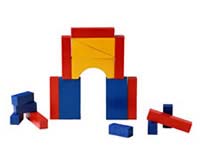Another nanobrick in the wall

Nanocubes could make polymer chemistry child’s play <br>© PhotoDisc <br>
Chemists make the world’s smallest building blocks.
US researchers have made the world’s smallest building blocks. The nanocubes are just a millionth of a millimetre (a nanometre) across1. Stacked like bricks, they could make up a range of materials with useful properties such as light emission or electrical conduction.
Many chemists are currently trying to develop molecular-scale construction kits in which the individual components are single molecules to provide the polymers of the future. Conventional polymers are chainlike molecules. These entangle to form plastics ranging from soft polyethylene to hard polystyrene.
Chemists can exert some influence over the properties of the bulk plastic by altering the shape and composition of the molecular chains. But they have little control over how the chains weave together.
Richard Laine and colleagues at the University of Michigan in Ann Arbor want to replace chains with bricks. Their molecular units are silicon and oxygen atoms linked into a cube-shaped framework with a silicon at each corner.
The researchers connect the cubes by their corners – each corner silicon has a ’spare’ bond to which other chemical groups can be attached.
Similar materials have been prepared previously using corner linkers made from chainlike hydrocarbons. Like cubic octupi with eight arms, these are of limited practical value because they decompose quite easily when heated, and form messy glass-like solids instead of well-ordered crystals with the cubes stacked precisely.
Laine’s team address this problem by replacing the loose, chain-like linker arms with stiff, stubby arms: compact aromatic molecules derived from benzene. These should make the resulting materials more stable and rigid.
For example, the nanocubes make a curable resin that can withstand heating above 500 oC in air. And by appending different molecular groups to the short benzene-like arms, the researchers have made a material that conducts electricity, which might be used in polymer-based light-emitting diodes for display devices. A third kind of cubic molecule emits green light and could be useful in sensors and displays.
References
- Tamaki, R., Tamaki, Y., Asuncion, M. Z., Choi, J. & Laine, R. M. Octa(aminophenyl)silsesquioxane as a nanoconstruction site. Journal of the American Chemical Society, 123, 12416 – 12417, (2001).
Media Contact
More Information:
http://www.nature.com/nsu/011220/011220-6.htmlAll latest news from the category: Life Sciences and Chemistry
Articles and reports from the Life Sciences and chemistry area deal with applied and basic research into modern biology, chemistry and human medicine.
Valuable information can be found on a range of life sciences fields including bacteriology, biochemistry, bionics, bioinformatics, biophysics, biotechnology, genetics, geobotany, human biology, marine biology, microbiology, molecular biology, cellular biology, zoology, bioinorganic chemistry, microchemistry and environmental chemistry.
Newest articles

Machine learning algorithm reveals long-theorized glass phase in crystal
Scientists have found evidence of an elusive, glassy phase of matter that emerges when a crystal’s perfect internal pattern is disrupted. X-ray technology and machine learning converge to shed light…

Mapping plant functional diversity from space
HKU ecologists revolutionize ecosystem monitoring with novel field-satellite integration. An international team of researchers, led by Professor Jin WU from the School of Biological Sciences at The University of Hong…

Inverters with constant full load capability
…enable an increase in the performance of electric drives. Overheating components significantly limit the performance of drivetrains in electric vehicles. Inverters in particular are subject to a high thermal load,…





















